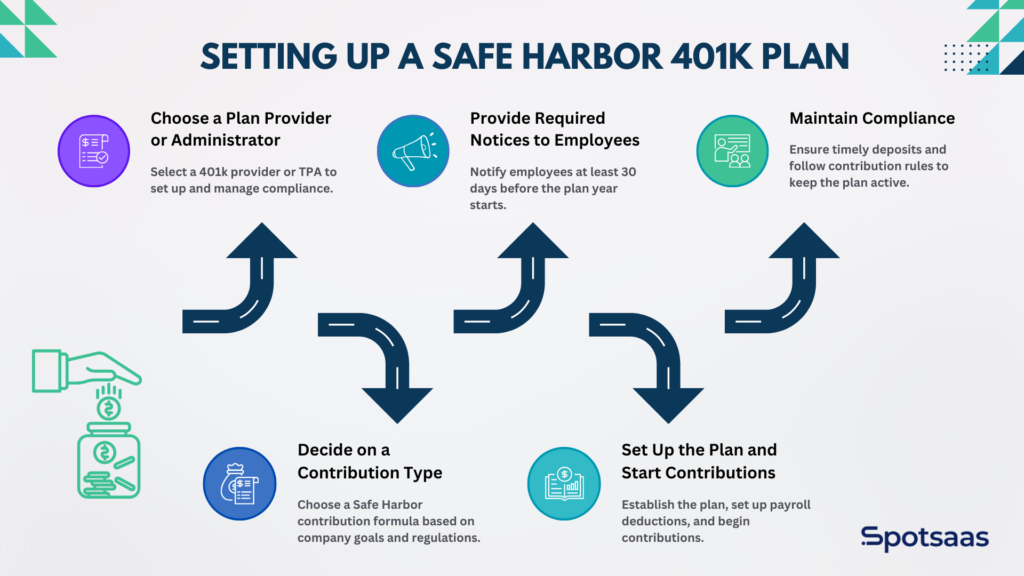The 401k plan is the most common area for retirement savings for both businesses and employees. It is an arrangement whereby employees can have a percentage withheld from their salary, which grows without any immediate tax consequences and can, in many instances, receive contributions from their employer toward that account.
The concept of a Safe Harbor 401k now comes into play. By helping employers pass IRS nondiscrimination tests and automatically ensuring compliance with contribution rules, a Safe Harbor 401k plan directly requires employers to guarantee contributions to any of their employees’ accounts.
In exchange, employers avoid annual testing, while high-income employees are allowed to contribute the maximum allowable amounts without restrictions. A Safe Harbor 401k can be the answer to retirement planning offering simplicity, flexibility, and the potential for larger contributions.
What Is a Safe Harbor 401k?
A Safe Harbor 401k is a retirement savings plan which contains employer-specific contributions. A Safe Harbor 401k lets employers skip complex IRS testing rules. A Safe Harbor 401k ensures every employee is treated equally in regard to contributions but enables highly compensated employees and owners to maximize contributions with few restrictions.
How It Differs from a Traditional 401k
A Traditional 401k requires businesses to perform IRS nondiscrimination tests, such as the Actual Deferral Percentage test and Actual Contribution Percentage tests. These tests ensure that higher-paid employees do not disproportionately benefit compared to lower-paid employees.
On the flip side, a Safe Harbor 401k automatically meets IRS testing requirements by observing specific rules governing employer contributions. Employers are required to contribute a fixed percentage of employee salaries – via either matching or non-elective contributions- completely removing the mirror focus on a compliance test.
Key Differences at a Glance
| Feature | Safe Harbor 401k | Traditional 401k |
|---|---|---|
| Employer Contributions | Mandatory | Optional |
| IRS Compliance Testing | Not required | Required |
| High-Earner Contribution Limits | No restrictions | Limited if the plan fails testing |
| Vesting Options | Immediate or graded | Employer’s choice |
| Best For | Small businesses, high earners | General workforce |
How a Safe Harbor 401k Works
A Safe Harbor 401k aims to simplify retirement savings for employers and employees, provided they conform with IRS regulation. Unlike traditional 401k plans that need annual tests to assess fairness in contributions among employees, a Safe Harbor plan qualifies automatically for these by adhering to certain rules regarding employer-contribution types.
Contribution requirements for employers
To be designated a Safe Harbor 401k, employers must make contributions to employees’ accounts. These contributions must either be immediately vested or vested pursuant to a schedule as stated in the plan.
Contributions by employers under a Safe Harbor plan generally fall into two categories.
Matching Contributions:
Employers may decide to match a percentage of the contributions made by employees, though he or she may use one of the following formulas:
- Basic Match: Only 100% of the first 3% of salary and then 50% of the next 2%.
- Enhanced Match: 100% of the first 4% of salary.
Non-Elective Contributions
Contributions a minimum of 3% of all eligible employees’ salaries, no matter if employees contributed or not. This process expedites retirement savings for employees and, in addition, keeps the employers safe from the complications of IRS testing.
Nondiscrimination Testing: IRS Rule
Traditional 401k plans are nondiscriminatory, and in their evaluation, IRC imposes tests to ensure that they do not disproportionately benefit high-paid employees or owners. Therefore, two principal tests stand:
- ADP: Actual Defense Percentage Test. What this is used to determine is if highly compensated employees are deferring substantially more from their paycheck than the rest of the non-highly compensated employees.
- ACP: Actual Contribution Percentage Test. This test evaluates matching contributions of the employer and voluntary after-tax employee contributions to assure fairness for all employees.
By avoiding tests that keep the contributions of business owners and high-earning employees in check, a Safe Harbor 401k permits contributions by the latter up to statutory limits. This makes this program a good option for companies that want to ease out of compliance issues and provide employees with a worthy retirement benefit.
Types of Safe Harbor 401k Employer Contributions
Employers who offer a Safe Harbor 401k plan must contribute to their employees’ retirement accounts in one of three ways: basic matching, enhanced matching, or non-elective contributions. These contributions ensure the plan meets IRS compliance requirements while helping employees grow their retirement savings.
| Type | Employer Contribution | Example |
|---|---|---|
| Basic Matching | 100% match on the first 3% of salary + 50% match on the next 2%. |
– Employee earns $50,000 per year – Employee contributes 5% ($2,500) – Employer matches: • 100% of first 3% ($1,500) • 50% of next 2% ($500) – Total employer contribution: $2,000 |
| Enhanced Matching | 100% match on the first 4% of an employee’s salary. |
– Employee earns $50,000 per year – Employee contributes 4% ($2,000) – Employer matches 100% of that amount ($2,000) – Total contribution to 401(k): $4,000 |
| Non-Elective Contribution | Employer contributes at least 3% of salary, whether or not the employee contributes. |
– Employee earns $50,000 per year – Employer contributes 3% ($1,500) automatically – Employee does not need to contribute anything |
Which Safe Harbor Contribution Type Is Best?
- Basic matching encourages employee contributions while keeping employer costs manageable.
- Enhanced matching provides a higher incentive for employees to save for retirement.
- Non-elective contribution guarantees employer-funded retirement savings for all employees, regardless of participation.
Each option has its own benefits, and the right choice depends on a company’s financial goals and employee retention strategy.
Benefits of a Safe Harbor 401k
A Safe Harbor 401k plan offers advantages for both employers and employees, making it a popular choice for businesses looking to simplify retirement benefits while staying compliant with IRS regulations.
For Employers
| Benefit | Description |
|---|---|
| Reduces Administrative Burden | Minimizes compliance complexities and paperwork, making it easier for employers to manage retirement plans. |
| Eliminates IRS Nondiscrimination Testing | Ensures compliance automatically, avoiding penalties and restrictions that could limit contributions for high earners. |
| Improves Employee Retention | Guaranteed employer contributions make the plan more attractive, helping to retain and recruit employees. |
| Allows Maximum Contributions | Business owners and highly compensated employees can contribute up to the IRS limit without facing restrictions due to testing failures. |
| Provides Tax Advantages | Employer contributions are tax-deductible, reducing the company’s taxable income while supporting employee retirement savings. |
For Employees
| Benefit | Description |
|---|---|
| Financial Security | Provides employees with a stable and structured way to build retirement savings with employer support. |
| Guaranteed Employer Contributions | Employees receive contributions from their employer, even if they contribute little or nothing themselves. |
| Immediate Vesting Options | Some Safe Harbor plans offer immediate vesting, allowing employees to fully own employer contributions right away. |
| Encourages Retirement Savings | Employer contributions create an incentive for employees to save more for their future. |
| Higher Contribution Limits | Employees can contribute up to the same IRS limits as a traditional 401(k), maximizing their retirement savings potential. |
A Safe Harbor 401k is a win-win for businesses and employees, providing financial stability, tax benefits, and a simple way to save for the future.
Safe Harbor 401k Plan Guidelines and Compliance
Safe Harbor 401k plans have rules for fairness and automatic IRS approval. These rules mainly pertain to employer contributions, employee notifications, and vesting schedules.
Mandated Employer Contributions
Employers must contribute to some or all of their employees’ 401(k’) accounts using one of several permitted Safe Harbor contribution formulas. The contributions are required to keep the plan compliant and provide an exemption from IRS nondiscrimination testing. Employers can use:
- Basic Match: total match with 100 percent on the first 3 percent of an employee’s earnings, 50 percent on the next 2 percent; or
- Enhanced Match: total match with 100 percent on the first 4 percent of an employee’s earnings or
The contributions ensure that all employees benefit from the plan so they can build retirement savings.
Annual Notice To Be Distributed
Every eligibility Safe Harbor 401k plan requires employers to provide an annual notice to all eligible employees. The notice must:
- Explain in detail the contributions employees will receive in Safe Harbor.
- Outline contribution structure, including basic match, enhanced match, or non-elective.
- Describe the rights of employees under the plan.
- Be distributed at least 30 days before the beginning of the plan year to allow employees to make informed decisions about contributing to their benefit plans.
Failure to provide this notice on time can lead to significant compliance city troubles along with related penalties.
Vesting Rules
Vesting tells an employee when they can obtain full ownership of employer contributions. Safe Harbor contributions can have either one of two types of vesting:
- Immediate vesting: Employees own 100 percent of employer-matched funds as soon as they are contributed
- Graded vesting: Employees are incrementally becoming vested with respect to their accounts, such as a yearly increase of 20 percent, with complete vesting occurring after five years.
Immediate vesting is common in many Safe Harbor plans, as it increases the plan’s attractiveness to employees and simplifies administration.
By following these Safe Harbor 401k rules, employers can maintain compliance, provide meaningful retirement benefits, and eliminate the need for IRS nondiscrimination testing.
Safe Harbor 401k Contribution Limits for 2024
Contribution limits for the Safe Harbor 401k are prescribed by the IRS so that no employee or employer exceeds set limits and so that retirement is optimized.
Employee Contribution Limit
For 2024, employees under age 50 may contribute a maximum of $23,000. Those aged 50 and older may make an additional catch-up contribution of $7,500, bringing their total permitted contributions to $30,500.
Employer Contributions
Employer contributions under a Safe Harbor 401k do not count toward the employee’s contribution limit but must conform to Safe Harbor provisions. Employers must make one of the mandated matching or nonelective contributions to ensure that all employees get some kind of retirement benefit.
Total Contribution Limit (Employee + Employer)
For the year 2024, the combined limit on employee and employer contributions is $69,000 for employees under the age of 50 and $76,500 for employees who are 50 or older. This total includes catch-up contributions.
The total limit gives employees the fullest opportunity for retirement savings through both employee and employer contributions.
Understanding these limits helps to give employees and employers perspective on making contributions and long-term planning for retirement.
Safe Harbor 401k vs. Traditional 401k- Key Differences
When choosing a 401k plan, employers must consider whether a Safe Harbor 401k or a Traditional 401k best suits their business needs. While both plans help employees save for retirement, they differ in terms of employer contributions, compliance requirements, and vesting rules.
| Feature | Safe Harbor 401(k) | Traditional 401(k) |
|---|---|---|
| Employer Contributions | Required (matching or non-elective contributions) | Optional |
| IRS Testing | Not required | Required annually to ensure fairness |
| Vesting | Immediate or graded, depending on plan design | Employer’s choice, can have a longer vesting schedule |
| Best For | Small businesses, high earners who want to maximize contributions without restrictions | General workforce, companies wanting more flexibility in contributions and vesting schedules |
Who Should Consider a Safe Harbor 401k?
A Safe Harbor 401k is an excellent choice for businesses that want to simplify retirement plan compliance while maximizing benefits for employees and owners. This plan is particularly beneficial for companies that face challenges with IRS nondiscrimination testing or want to offer a competitive retirement package.
| Who Benefits | Why a Safe Harbor 401(k) is Ideal |
|---|---|
| Small Business Owners | Allows full IRS-limit contributions without restrictions. Eliminates nondiscrimination testing and benefits both owners and employees. |
| Companies with Highly Compensated Employees | Removes contribution limits for high earners, ensuring they can contribute the maximum amount without IRS testing concerns. Ideal for firms with income disparities. |
| Employers Seeking a Competitive Benefits Package | Enhances employee retention with guaranteed contributions, simplifies administration, and strengthens the company’s benefits package. |
Small Business Owners
- A Safe Harbor 401k allows small business owners to contribute the maximum IRS limit without restrictions.
- Traditional 401k plans may limit contributions if the plan fails nondiscrimination testing, but Safe Harbor plans bypass these rules, ensuring full contribution eligibility.
- This is ideal for business owners who want to prioritize tax-deferred retirement savings while also benefiting their employees.
Companies with Highly Compensated Employees
- In a traditional 401k, highly compensated employees (HCEs) may face limits on how much they can contribute if lower-earning employees do not contribute enough.
- A Safe Harbor 401k eliminates these restrictions, allowing HCEs to contribute the full IRS limit without concern about plan testing failures.
- This is particularly useful for professional firms, tech startups, and small businesses where leadership and key employees earn significantly more than other staff members.
Employers Seeking a Competitive Benefits Package
- Offering guaranteed employer contributions through a Safe Harbor 401k makes a company’s benefits package more attractive.
- Helps improve employee retention and recruitment by providing a valuable financial incentive for long-term savings.
- Employers who want to reduce administrative burdens while still offering a strong retirement plan will find Safe Harbor plans a simple and effective solution.
For businesses looking to enhance retirement savings, attract top talent, and avoid IRS compliance headaches, a Safe Harbor 401k is a smart and strategic choice.
Setting Up a Safe Harbor 401k Plan
Careful planning and IRS instruction are required for consideration in forming a Safe Harbor 401k plan. The above steps ensure a smooth formation with compliance with all regulations.

Step 1: Choose a Plan Provider or Administrator
Choosing a 401k provider or TPA does come first. They will help when setting up the plan, overseeing compliance requirements, and handling records.
Employers should compare all providers, factoring in fees, investment options, and administrative support.
Step 2: Decide on a Contribution Type
The employer should select one of the Safe Harbor contribution formulas. There are three options:
- Basic Match: A 100 percent match on the first 3 percent of salary, along with a 50 percent match on the next 2 percent
- Enhanced Match: A 100 percent match on the first 4 percent salary.
- Non-Elective: A contribution equal to at least 3 percent of each employee’s salary, whether or not they contribute toward the plan.
The employer should base their decision on corporate goals, financial conditions, and Safe Harbor compliance issues.
Step 3: Provide Required Notices to Employees
Employers must notify all eligible employees of the Safe Harbor plan. Employers must send a notice at least 30 days before the start of the plan year, allowing employees a reasonable time to make decisions before contributions come into effect.
Step 4: Set Up the Plan and Start Contributions
After the plan has been implemented, the employer needs to establish the plan with the provider, set up payroll deductions, and start contributions. Employees can also begin contributing on their own.
Step 5: Maintain Compliance
Ongoing compliance is very important to keep the Safe Harbor 401k plan alive. The employer must comply with the contribution formula chosen and deposit the contributions.
Conclusion
A Safe Harbor 401k plan provides a structured and compliant way for businesses to offer retirement benefits while avoiding IRS nondiscrimination testing. With guaranteed employer contributions, higher contribution limits for highly compensated employees, and potential tax advantages, it serves as a valuable option for companies looking to attract and retain talent.
This plan is especially beneficial for small business owners, companies with high-income earners, and employers seeking a competitive benefits package. Ensuring all employees receive contributions encourages long-term savings and financial security.
For businesses considering a Safe Harbor 401(k), consulting a financial advisor or plan provider can help determine the best contribution structure and ensure compliance with regulatory requirements. Making an informed decision can lead to a more effective retirement plan that benefits both employers and employees.
Frequently Asked Questions
What is a Safe Harbor 401k plan?
A Safe Harbor 401k is a retirement plan that requires employers to make mandatory contributions to employees’ accounts. In return, the plan is exempt from IRS nondiscrimination testing, allowing highly compensated employees to contribute the maximum limit without restrictions.
How does a Safe Harbor 401k differ from a traditional 401k?
Unlike a traditional 401(k), a Safe Harbor 401(k) requires employer contributions but eliminates the need for IRS nondiscrimination testing. This ensures that all employees receive a fair retirement benefit, and business owners can contribute up to the IRS limits without restrictions.
Does a Safe Harbor 401(k) require an annual notice to employees?
Yes, employers must provide a written notice to all eligible employees at least 30 days before the plan year starts. This notice outlines the employer’s contribution structure and employee rights.
Can employees opt out of a Safe Harbor 401(k) plan?
Yes, employees can choose not to participate in a Safe Harbor 401(k) by opting out of making contributions. However, if the employer offers a non-elective contribution, employees will still receive the employer’s contribution even if they do not contribute to the plan themselves.
What happens to Safe Harbor contributions if an employee leaves the company?
If the plan follows immediate vesting, the employee keeps 100% of the employer contributions when they leave. If the plan has a graded vesting schedule, the employee may only take the vested portion, and the remaining balance may be forfeited.





